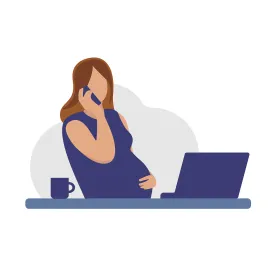On August 11, 2023, the U.S. Equal Employment Opportunity Commission (EEOC) formally published proposed regulations to implement the Pregnant Workers Fairness Act (PWFA). In a matter of just under 9 months, since the law was enacted at the end of 2022, the EEOC crafted 275+ pages worth of regulations, preamble and interpretive guidance to fill in the gaps found in the 10 page statute. The proposed regulations contain some interpretations that were largely expected and some surprises. The proposed regulations are subject to a 60-day comment period and will surely change before being finalized. The PWFA requires the EEOC to issue final regulations by December 29, 2023. For a deep dive into the proposed regulations, check out our article here. Below is a quick overview of some of the important questions addressed by the EEOC in the proposed regulations.
-
Who is entitled to an accommodation? Qualified employees limited due to pregnancy, childbirth and related medical condition, as long as the accommodation does not create an undue hardship. Unlike the ADA, an employee who cannot perform their essential duties may still be qualified.
-
What is a “known limitation”? A mental or physical impediment or problem related to pregnancy, childbirth or related medical conditions, including common or minor conditions that has been communicated to the employer.
-
What types of conditions and circumstances are included under the umbrella of “pregnancy, childbirth and related medical conditions”? Conditions that are commonly associated with pregnancy and childbirth, as well as many others that may not be.
-
The PWFA says that an employee can be qualified, and therefore eligible for accommodations when the employee has a temporary inability to perform the essential job functions. How long does an employer have to excuse an employee from performing essential functions? The proposed regulations require employers excuse essential job functions for generally up to 40 weeks per accommodation request, subject to undue hardship.
-
If the employee can perform the essential functions of the job but will need an accommodation to do so, does the limitation have to be temporary? No.
-
When does accommodating an employee who cannot perform the essential functions of the job create an undue hardship? An employer may be able to demonstrate an undue hardship when removing an essential function would impose significant difficulty or expense. The proposed regulations identify factors for employers to consider.
-
Do the regulations provide a list of common accommodations for pregnant employees that employers should usually grant quickly and without supporting documentation? Yes.
-
If an employee requests leave as an accommodation, how much leave must an employer provide? There is no bright line rule.
-
If an employee has paid leave available under a state or local paid sick leave law or under an employer provided paid leave policy or benefit program, can the employee be required to use that paid leave to run concurrently with time off as a reasonable accommodation under the PWFA? No, employees must be given the opportunity to choose in the same manner employees on other types of leave are permitted to choose.
-
Can an employer choose to provide an alternative, effective accommodation? In most cases, yes.
-
Can employers ask for medical documentation to support an accommodation request? Sometimes.
-
How long should it take to process a PWFA reasonable accommodation request? It depends.
-
Are employers required to provide lactation accommodations under the PWFA? Yes, absent undue hardship.
-
How should employers manage concerns that the workplace or the position presents safety risks for the pregnant employee or the pregnancy? Safety can still be part of the undue hardship analysis.
-
Other than the four common accommodations for pregnant employees discussed above, does the EEOC give employers guidance on what kind of accommodations might be considered reasonable, absent undue hardship? The EEOC has provided a non-exhaustive list of possible accommodations.
-
If the employee is granted an accommodation that reduces the employee’s work time, does the employer have to do anything else to make the accommodation effective? Perhaps.
Six Steps To Consider Taking Now
There are six steps employers may want to consider taking now.
-
Review the proposed regulations, and the examples included in the proposed regulations so you can better understand how the EEOC is currently interpreting this new law.
-
When handling accommodation requests, keep in mind that if another federal, state or local law provides greater protection or different requirements, those laws will also apply. Currently there are 30 states and 5 local jurisdictions with their own version of the PWFA or a pregnancy accommodation law.
-
Covered employers are required to post notices describing the PWFA. An updated EEO poster is available on the EEOC website.
-
Consider whether changes need to be made to existing forms and practices to comply with the PWFA and in light of the proposed regulations while recognizing that these regulations are subject to change.
-
Consider training your HR professionals, managers and first-line supervisors on how to identify and respond to requests for PWFA accommodations.
-
Consider whether you want to submit comments on the EEOC’s proposed regulations during the 60-day comment period.
The most important thing to do at this stage is to keep in mind that these proposed regulations are just that—proposed. They represent the EEOC’s current interpretation of the PWFA before the agency has had an opportunity to consider comments and questions from the public. The proposed regulations will undoubtedly be revised after the comment period expires and a final set of regulations will be issued.








 />i
/>i
